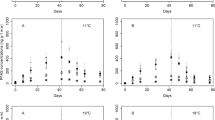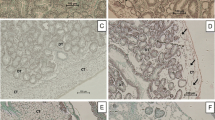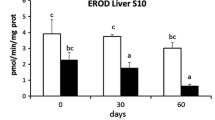Abstract
Juvenile starry flounder (Platichthys stellatus) maintained at 4° or 12°C were forced-fed3H-1-naphthalene. At 24 hr, after the initiation of exposure, significantly (p < 0.05) higher concentrations (2 to 15 times) of naphthalene were present in tissues of starry flounder at 4°C than those present in fish held at 12°C. The influence of lowering of water temperature on naphthalene retention was even more marked after one week. At this time, muscle and liver of fish at 4°C contained 26 and 34 times, respectively, more naphthalene than did muscle and liver of fish at 12°C. Concentrations of total metabolites, in most tissues were not substantially higher at the lower temperature either 24 or 168 hr after the naphthalene-exposure.
Thin-layer Chromatographic separation of the metabolites revealed that at 24 hr, 1,2-dihydro-1,2-dihydroxynaphthalene (dihydrodiol) was the major component in liver (40 to 50% of extracted metabolites) and muscle (∼-80% of extracted metabolites) regardless of the temperature. Bile contained, primarily, conjugates (e.g., glucuronides), which yielded the dihydrodiol as the principal metabolite on enzymatic hydrolysis. From 24 to 168 hr, the concentrations of each metabolite class did not vary directly with the concentrations of total metabolites. Accordingly, at 168 hr, the ratio of total metabolite concentrations in liver of fish at 4°C compared to 12°C was 1.6, whereas the ratios for the dihydrodiol, sulfate/glucoside conjugates and glucuronide conjugates were 4.5, 0.6 and 3.8 respectively.
Generally, lowered water temperature increased tissue concentrations of the parent hydrocarbon and its metabolites. However, the magnitude of the increase was dependent upon the compound, the tissue, and the time after the initiation of the exposure. The results emphasize the importance of determining concentrations of individual metabolites together with parent hydrocarbons in tissues of fish when assessing effects of environmental parameters on xenobiotic toxicity.
Similar content being viewed by others
References
Atlas, R. M., A. Horowitz, and M. Busdosh: Prudhoe crude oil in arctic marine ice, water, and sediment ecosystems: degradation and interactions with microbial and benthic communities. J. Fish. Res. Board Can.35, 585 (1978).
Anderson, J. W., J. Neff, B. Cox, H. Tatan, and G. M. Hightower: Characteristics of dispersions and water-soluble extracts of crude and refined oils and their toxicity on estuarine crustaceans and fish. Mar. Biol.27, 75 (1973).
Barrington, E. J. W.: The alimentary canal and digestion. In M. E. Brown (ed.): The physiology of fishes. Vol. 1, p. 109. New York: Academic Press (1957).
Brookes, P.: Mutagenicity of polycyclic aromatic hydrocarbons. Mutation Res.39, 257 (1977).
Burke, M. D., H. Vadi, B. Jernstrom, and S. Orrenius: Metabolism of benzo[α]pyrene with isolated hepatocytes and the formation and degradation of DNA-binding derivatives. J. Biol. Chem.252, 6424 (1977).
Collier, T. K., L. C. Thomas, and D. C. Malins: Influence of environmental temperature on disposition of dietary naphthalene in coho salmon (Oncorhynchus kisutch): Isolation and identification of individual metabolites. Comp. Biochem. Physiol.61c, 23 (1978).
Collier, T. K., M. M. Krahn, and D. C. Malins: The disposition of naphthalene and its metabolites in the brain of rainbow trout (Salmo gairdneri). Environ. Res. In press (1980).
Dodgson, K. S., J. I. M. Lewis, and B. Spencer: The arylsulfatase and glucuronidase of marine molluscs. Biochemical Journal55, 253 (1953).
Durkin, J. T., S. J. Lipovsky, G. R. Snyder, and J. M. Shelton: Changes in epibenthic estuarine fish and invertebrates from propeller agitation dredging. Report to North Pacific Division for Corps of Engineers. (DACW 57-76-C-0123) (1977).
Fucik, K. W., J. M. Neff, and M. L. Byington: Effects of temperature and salinity on naphthalenes uptake in the temperate clam,Rangia cuneata and the boreal clamPrototheca staminea. In D. A. Wolfe (ed.): Fate and effects of petroleum hydrocarbons in marine ecosystems and organisms. New York: Pergamon Press (1977).
Harris, R. P., V. Berdugo, E. D. S. Corner, C. C. Kilvington, and S. C. M. O'Hara: Factors affecting the retention of a petroleum hydrocarbon by marine planktonic copepods. In D. A. Wolfe (ed.): Fate and effects of petroleum hydrocarbons in marine ecosystems and organisms. New York: Pergamon Press (1977).
Hazel, J. R.: Influence of thermal acclimation on membrane lipid composition of rainbow trout liver. Am. J. Physiol.236, R91 (1979a).
Hazel, J. R.: Influence of temperature adaptation on composition of the neutral lipid fraction of rainbow trout (Salmo gairdneri) liver. J. Exp. Zool.207, 33 (1979b).
Hesse, S., and M. Mezger: Involvement of phenolic metabolites in the irreversible protein-binding of aromatic hydrocarbons: Reactive metabolites of [14C] naphthalene and [14C] 1-naphthol formed by rat liver microsomes. Mol. Pharmacol.16, 667 (1979).
Hochachka, P. W., and G. N. Somero: Biochemical adaptation to the environment. In W. S. Hoar and P. J. Randall (eds): Fish physiology. Vol. VI, p. 99. New York: Academic Press (1971).
Hodgins, H. O., B. B. McCain, and J. W. Hawkes: Marine fish and invertebrate diseases, host disease resistance, and pathological effects of petroleum. In D. C. Malins (ed.): Effects of petroleum on arctic and subarctic marine environments and organisms. Vol. II, p. 95. New York: Academic Press (1977).
Kapitulnik, J., W. Levin, A. H. Conney, H. Yagi, and D. M. Jerina: Benzo[α]pyrene 7,8-dihydrodiol is more carcinogenic than benzo[α]pyrene in newborn mice. Nature266, 378 (1977).
Krahn, M. M., D. W. Brown, T. K. Collier, A. J. Friedman, R. G. Jenkins, and D. C. Malins: Rapid analysis of naphthalene and its metabolites in biological systems: Determination by high performance liquid chromatography/fluorescence detection and by plasma desorption chemical ionization mass spectrometry. J. Biochem. Biophys. Methods2, 233 (1980).
Lee, R. F., R. Sauerheber, and G. H. Dobbs: Uptake, metabolism and discharge of polycyclic aromatic hydrocarbons by marine fish. Mar. Biol. (Berl.)17, 201 (1972).
Malins, D. C.: Metabolism of aromatic hydrocarbons in marine organisms. Ann. N.Y. Acad. Sci.298, 482 (1977).
Moore, S. F., and R. L. Dwyer: Effects of oil on marine organisms: A critical assessment of published data. Water Res.8, 819 (1974).
Norwich, K. H.: Molecular dynamics in biosystems. New York: Pergamon Press (1977).
Roubal, W. T., T. K. Collier, and D. C. Malins: Accumulation and metabolism of carbon-14 labeled benzene, naphthalene, and anthracene by young coho salmon (Oncorhynchus kisutch). Arch. Environ. Contain. Toxicol.5, 513 (1977).
Sims, P., and P. L. Grover: Epoxides in polycyclic aromatic hydrocarbon metabolism and carcinogenesis. In G. Klein, S. Weinhouse, and A. Hadden (eds.): Advances in cancer research. Vol. 20, p. 165. New York: Academic Press (1974).
Stegeman, J. J.: Temperature influence on basal activity and induction of mixed function oxygenase activity inFundulus heteroclitus, J. Fish. Res. Board Can.36, 1400 (1979).
Varanasi, U., D. J. Gmur, and P. A. Treseler: Influence of time and mode of exposure on biotransformation of naphthalene by juvenile starry flounder (Platichthys stellatus) and rock sole (Lepidopsetta bilineata). Arch. Environ. Contam. Toxicol.8, 673 (1979).
Varanasi, U., and D. C. Malins: Metabolism of petroleum hydrocarbons: Accumulation and biotransformation in marine organisms. In D. C. Malins (ed): Effects of petroleum on arctic and subarctic marine environments and organisms. Vol. II, p. 175. New York: Academic Press (1977).
Varanasi, U., M. Uhler, and S. I. Stranahan: Uptake and release of naphthalene and its metabolites in skin and epidermal mucus of salmonids. Toxicol. Appl. Pharmacol.44, 277 (1978).
Author information
Authors and Affiliations
Rights and permissions
About this article
Cite this article
Varanasi, U., Gmur, D.J. & Reichert, W.L. Effect of environmental temperature on naphthalene metabolism by Juvenile Starry flounder (Platichthys stellatus). Arch. Environ. Contam. Toxicol. 10, 203–214 (1981). https://doi.org/10.1007/BF01055622
Received:
Accepted:
Issue Date:
DOI: https://doi.org/10.1007/BF01055622




